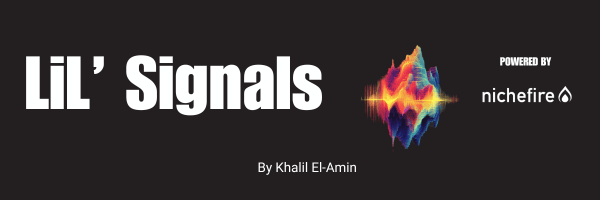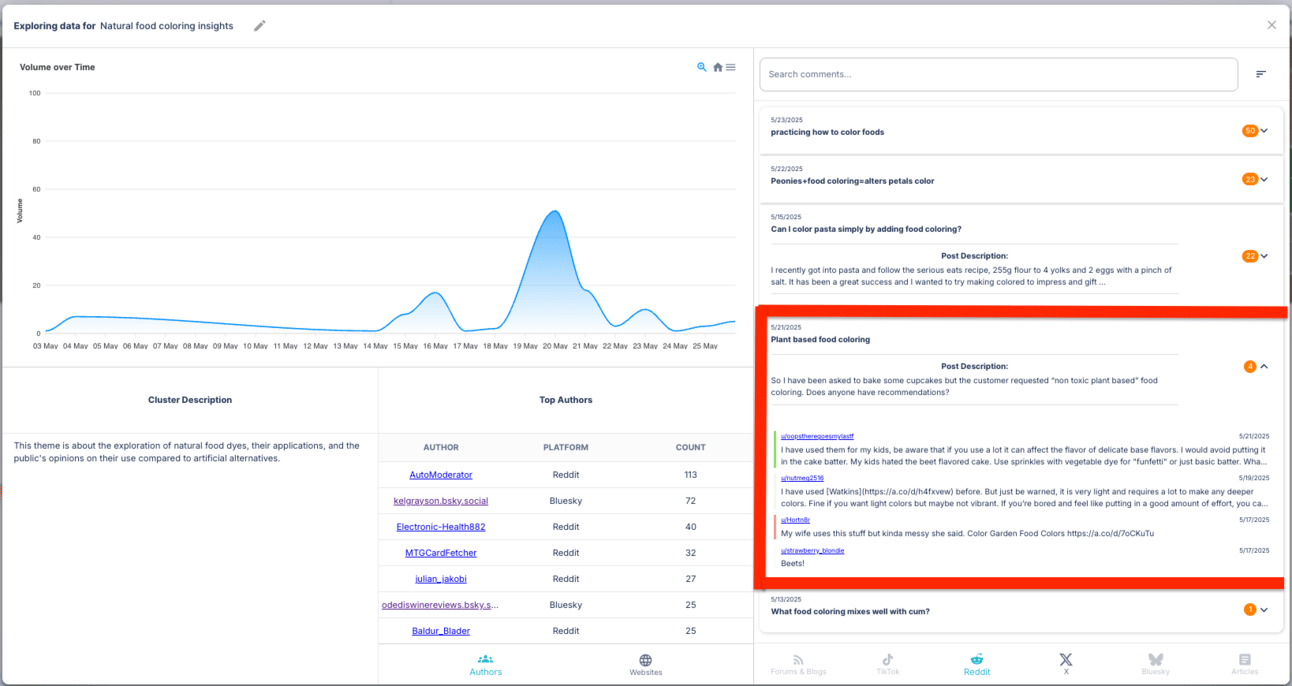- Lil' Signals
- Posts
- Lil’ Signals: Red, White, and Banned
Lil’ Signals: Red, White, and Banned
How MAHA is turning ingredient labels into cultural flashpoints—and what brands must do to stay relevant.

👋🏽 Hey There
Lil’ Signals is your go-to newsletter for decoding the cultural currents shaping our world. Powered by Nichefire’s cutting-edge technology, we break down trends, tell compelling stories, and share actionable insights on how to tap into the power of cultural listening.
Stay ahead of the curve—one signal at a time.
In this edition, we’re trading luxury gowns for lunch trays, because Gen Z’s most influential stage might just be the dinner table.
At Nichefire, we’ve seen culture remix itself across fashion, entertainment, and identity. But some of the most potent cultural shifts? They’re happening in your grocery cart. Food is no longer just fuel; it’s content, commentary, and community.
From TikTok’s “Girl Dinner” to protein-fueled micro-crews, Gen Z is forming dietary tribes that reflect not just taste, but purpose, politics, and personal expression. These aren't just trends, they're belief systems. And they’re shaping the future of food and beverage innovation at a breakneck pace.
That’s why this week’s Storytime digs into the next evolution of food tribalism, and why cultural listening is the tool that can help you decode what’s emerging, what’s sticking, and what your team should act on next.
Because if you want to be on the shelf, in the feed, and ahead of the curve, this is the signal you can’t afford to miss.
Let’s dive in! 🎯
Table of Contents

StoryTime
Storytime: Red, White, and Banned – Culture in the Age of MAHA

This spring, a cultural signal blipped onto our radar, not from Gen Z slang or TikTok dances, but from Capitol Hill.
Robert F. Kennedy Jr., now serving as Secretary of Health and Human Services, launched his “Make America Healthy Again” (MAHA) initiative.
It kicked off with bold bans on synthetic food dyes (like Red 3 and Blue 1) and is now heading toward fluoride in drinking water.
But let’s not mistake this for just another political headline.
Because underneath the policy dust-up is something bigger: a cultural shift in motion. A signal. And where there’s a signal, there’s opportunity.
Dyes Out, Culture In
To start, RFK Jr. didn’t just ban Red Dye No. 3.
He’s set the table for banning eight of the most commonly used synthetic food dyes in the U.S., colors that light up our candy aisles, cereal boxes, flavored drinks, and even chicken sandwiches.
The immediate reaction?
Controversy. Pushback. The usual storm of media takes.
But while the political world bickers over health claims and conspiracies, something quieter and more powerful is happening.
Consumer perception is changing.
Colors we’ve long accepted without question are now cultural liabilities.
Parents are rethinking what they feed their kids.
Wellness influencers are spotlighting beet juice and turmeric.
And perhaps most importantly, there’s rising curiosity about what’s really inside the foods we love.
Nichefire is already seeing spikes in cultural conversations around “natural food coloring,” “dye-free candy,” and DIY recipes using black carrots or butterfly pea flower.

The debate may have started in politics, but it’s becoming personal. Emotional. Everyday.
New Growth Opportunities
This isn’t just a consumer moment. It’s a signal for innovation.
Red 3 is being phased out, and the countdown has begun. '
With the FDA’s ban in motion, brands have until 2027 to reformulate.
But swapping in a natural dye isn’t enough; consumers expect a story.
Why this ingredient? What’s the benefit? Where’s it from? Transparency isn’t optional. It’s table stakes.
That opens doors for:
Urban farming and micro-agriculture partnerships,
New supply chains around niche crops (think beetroot extract or spirulina),
And storytelling built on transparency, traceability, and local pride.
Even the look and feel of foods may evolve, with slightly duller reds and more earthy tones.
That might sound minor, but for brands that built their identity around bright, vibrant visuals, this will be a forced reinvention.
Yes, it's a headache. But it's also a chance to lead.
Fluoride: The Next Flashpoint
Next up in MAHA? Fluoride.
And just like with dyes, the fluoride ban isn’t the point; it’s the cultural ripple that matters.
If fluoride is pulled from municipal water, how do we rethink dental hygiene? What does that mean for CPGs in oral care?
Think less about panic headlines and more about:
Re-education campaigns led by toothpaste brands,
New product adoption driven by “fluoride microdosing” routines,
Influencer-led oral health tutorials,
Even school-based hygiene initiatives in fluoride-free districts.
The smart brands won't wait for mandates; they’ll own the new narrative.
Behavior > Policy
Here’s what cultural listening reminds us: People don’t move because of laws. They move because of meaning.
RFK Jr. may hold the pen on federal policy, but consumers hold the power to shape culture.
And as they reassess their relationship with color, chemicals, and health, the brands that tune into that tension, not just react to it, will be the ones who win.
MAHA may be the acronym. But the real signal? Meaningful Adaptation Helps Audiences.
Signal Summary
Here’s what we’re seeing in Nichefire:
Positive trend trajectory for “natural dyes,” especially in cooking and parenting forums.
Mixed (but high-volume) sentiment around fluoride, high curiosity from younger parents, and concern from legacy dental professionals.
Political conversations are noisy, but product conversations are practical: "What do I buy now?" "Does this change my routine?" "What tastes different?"
These are the questions brands should be listening to, and answering.
Culture doesn’t shift in headlines.
It shifts in grocery aisles, medicine cabinets, and kitchen tables.
These bans, while controversial, are simply accelerators of a broader trend: the cultural reevaluation of what’s “healthy.”
We’re not just watching a political moment.
We’re watching a cultural transformation in real time.
Let’s not waste the opportunity.
Stay curious. Stay connected. Stay ahead.
Let’s decode what’s next. Together.
Let’s explore the power of culture, one signal at a time.

Cultural Listening 101
Cultural Listening 101: Sensing the Signals That Shape Strategy
Let’s talk about the first step in building with culture: Cultural Sensing.
This isn’t just about spotting trends—it’s about developing a system for capturing the signals early enough to do something with them. In this week’s Cultural Listening 101, I want to break down how we use cultural sensing at Nichefire and how you can use it to fatten up your product pipeline before your competitors even realize there’s a shift.
Start Wide, Then Dive Deep
Cultural sensing starts at 10,000 feet. I begin by setting up a wide data view—what we call a default dataset. This gives me a macro lens on culture across platforms like Reddit, Twitter, TikTok, and Google.
For this example, I chose Health and Personal Development. Inside that space, one cluster stood out: Gen Z financial optimism. It’s not necessarily positive, there’s tension, even frustration, but the conversation volume is up, and that's a signal in itself.
The key is not just seeing the spike, but understanding what's behind it.
From Trend to Opportunity
Zooming into the cluster, I found something intriguing: a Reddit thread on r/Singularity (a community of nearly 4 million members) where users were expressing frustration around the value of college degrees. One quote hit me:
“My degree was a waste of time and money, even before AI existed.”
That one sentence opened up a whole rabbit hole.
With the help of a GPT-powered prompt, I analyzed the full thread for pain points and unmet needs. What came back was powerful:
A mismatch between traditional academic curriculums and actual job requirements.
Anxiety about debt with no clear career ROI.
A shift toward modular, skill-based education, often powered by AI.
This is cultural gold.
Translating Signals into Strategy
So what do we do with this?
If you’re in CPG, QSR, or retail, maybe not much, yet, but if you’re in edtech, personal finance, career development, or HR tech, this could be your cue.
Opportunities include:
AI-powered career transition tools
Affordable, skill-based micro-certifications
Platforms that teach soft skills alongside technical ones
Tools for employers to assess skills outside of formal degrees
If Gen Z is leading this shift, Gen Alpha will likely normalize it. That gives you a cultural window to develop new products, update messaging, or reposition your brand to align with this evolving value system.
Why This Matters
The magic of cultural sensing isn’t in the dashboard. It’s in how you connect the dots between where attention lives today and what it could mean tomorrow. This is the heart of what Nichefire enables.
We don’t just show you what’s trending. We show you why it matters—and what to do next.
If you’re ready to stop reacting and start building with culture, I’d love to walk you through what we’re building.
Want help replicating this inside your own category?
Reach out for a walkthrough and start making cultural listening work for you.
See you next week for another installment of Cultural Listening 101.
Thank you for subscribing to Lil’ Signals. If you enjoyed this post or know someone who may find it useful, please share it with them and encourage them to subscribe:

Content Engines
I want to see what you can create!
Got a cool AI-generated video?
Creative Experiment?
A bold Idea?
Share it with me!
Reply to this email with your best creations, and let’s see who’s leading the AI content revolution. 📤✨

Top Cultural Trends
Stay Ahead with Nichefire
In this new section, we’re diving into Nichefire’s unique tools to explore the top cultural trends shaping our world.
This week, we break down key insights from the Movements Matrix, spotlighting high-growth and emerging trends across 47 cultural categories
Spot Emerging Trends: Discover niche opportunities before they hit the mainstream.
Actionable Insights: Leverage cultural data to make faster, smarter decisions.
Comprehensive View: Analyze trends across 47 pre-trained cultural categories.
Lil’ Surfing 🌊
Just interesting articles I find on “The Internets” 😜

💬 Your journey into the world of cultural insights starts here!
Thank you for being part of the Lil’ Signals community. Together, we’ll decode the world, one signal at a time.
Reply